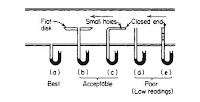Local Static Pressure In a moving fluid, the local static pressure is equal to the pressure on a surface which moves with the fluid or to the normal pressure (for newtonian fluids) on a stationary surface which parallels the flow. The pressure on such a surface is measured by making a small hole perpendicular to the surface and connecting the opening to a pressure-sensing element. The hole is known as a piezometer opening or pressure tap.

Measurement of local static pressure is frequently difficult or impractical. If the channel is so small that introduction of any solid object disturbs the flow pattern and increases the velocity, there will be a reduction and redistribution of the static pressure. If the flow is in straight parallel lines, aside from the fluctuations of normal turbulence, the flat disk and the bent tube give satisfactory results when properly aligned with the stream. Slight misalignments can cause serious errors. Diameter of the disk should be 20 times its thickness and 40 times the static opening; the face must be flat and smooth, with the knife edges made by beveling the underside.
The piezometer tube, such as that in, should have openings with size and spacing as specified for a pitot-static tube.
Readings given by open straight tubes are too low due to flow separation. Readings of closed tubes oriented perpendicularly to the axis of the stream and provided with side openings may be low by as much as two velocity heads.
Average Static Pressure In most cases, the object of a static pressure measurement is to obtain a suitable average value for substitution in Bernoulli's theorem or in an equivalent flow formula. This can be done simply only when the flow is in straight lines parallel to the confining walls, such as in straight ducts at sufficient distance downstream from bends (2 diameters) or other disturbances. For such streams, the sum of static head and gravitational potential head is the same at all points in a cross section taken perpendicularly to the axis of flow. Thus the exact location of a piezometer opening about the periphery of such a cross section is immaterial provided its elevation is known.
However, in stating the static pressure, the custom is to give the value at the elevation corresponding to the centerline of the stream. With flow in curved passages or with swirling flow, determination of a true average static pressure is, in general, impractical.
In metering, straightening vanes are often placed upstream of the pressure tap to eliminate swirl. Specifications for Piezometer Taps The size of a static opening should be small compared with the diameter of the pipe and yet large compared with the scale of surface irregularities. For reliable results, it is essential that (1) the surface in which the hole is made be substantially smooth and parallel to the flow for some distance on either side of the opening, and (2) the opening be flush with the surface and possess no "burr" or other irregularity around its edge.
